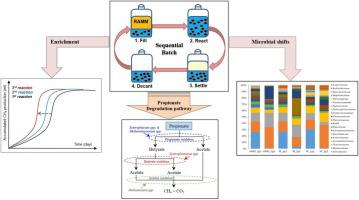Journal of Hazardous Materials ( IF 13.6 ) Pub Date : 2020-06-17 , DOI: 10.1016/j.jhazmat.2020.123230 Md Abu Hanifa Jannat 1 , Jangwoo Lee 1 , Seung Gu Shin 2 , Seokhwan Hwang 1

|
Propionate is a quantitatively important methanogenic intermediate in anaerobic digesters and only limited number of microbes can utilize it under syntrophic association with methanogens. The syntrophic propionate oxidizing bacterias are known to be slow growers due to the low energy yield. Thus, propionate get accumulated frequently in anaerobic digesters and it negatively affect digester performance. In this study, propionate degrading consortia from four different seeding sources were enriched in sequential bath mode in two phases; first adaption phase with 1 g/L of propionate concentration and later, high-strength phase with 3 g/L. From 16s rRNA gene based metagenomics analysis of the former phase, four syntrophic microbial groups, Syntrophaceae, Syntrophomonadaceae, Methanobacterium and Methanosaeta were found to be dominant with complete degradation of propionate. The substrate accelerated microbial shifts were observed at high-strength phase with significant decrease of Syntrophaceae up to 26.9 %. Using Response Surface Methodology, pH 6.8–6.9 and temperature 34.5–34.9 °C were found to be optimum growth conditions for the propionate degradation culture. Observed results could be useful to improve degradation efficiencies and obtained enriched culture can be used to recover propionate-accumulated digesters by bio-augmentation.
中文翻译:

厌氧丙酸氧化财团的长期富集:营养培养的发展和生长的优化。
丙酸是厌氧消化池中重要的产甲烷中间体,在与产甲烷菌的营养养分结合下,只有少数微生物可以利用它。由于能量产量低,已知腐殖酸的丙酸氧化细菌生长缓慢。因此,丙酸经常在厌氧消化池中积累,并对消化池性能产生负面影响。在这项研究中,来自四个不同播种源的丙酸降解联合体在两个阶段的连续浸浴模式中富集。丙酸浓度为1 g / L的第一个适应阶段,随后为3 g / L的高强度阶段。从的16S rRNA基因为基础宏基因组学前阶段的分析,四个互养微生物群体,Syntrophaceae,Syntrophomonadaceae,发现甲烷杆菌和甲烷甲烷菌占优势,丙酸酯完全降解。在高强度阶段观察到底物的微生物迁移加快,同食菌明显减少达26.9%。使用响应表面方法学,发现pH 6.8-6.9和温度34.5-34.9°C是丙酸降解培养物的最佳生长条件。观察到的结果可能对提高降解效率有用,获得的富集培养物可用于通过生物增强来回收丙酸积累的消化池。



























 京公网安备 11010802027423号
京公网安备 11010802027423号